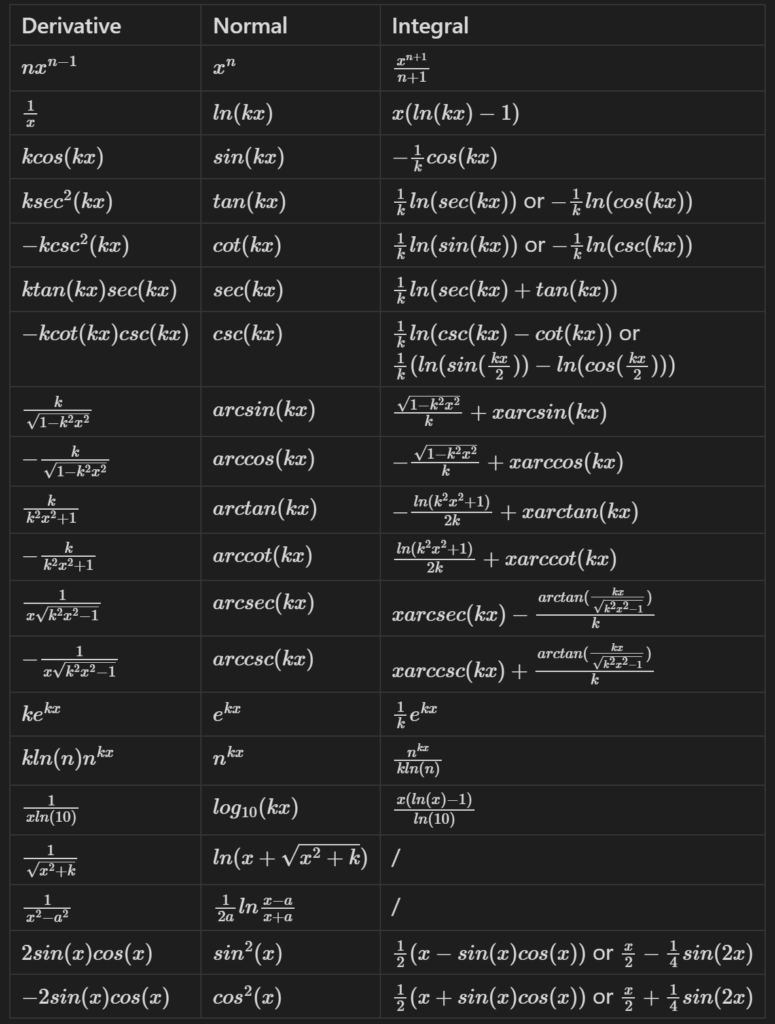For my university math course, I needed to make a cheat sheet with some common integrals and derivatives. I remember once seeing a table of functions with their integrals and derivatives, but I couldn’t find it again, so I made it again with the functions I found myself using the most. Below is a screenshot of the table (because I couldn’t find an easy way to embed Obsidian’s Markdown-LaTeX mix) and an unrendered LaTeX version. In the table, k and n are constants. For increased readability, you can replace k with 1.
Screenshot:

Unrendered LaTeX version:
| Derivative | Normal | Integral |
|---|---|---|
| $nx^{n-1}$ | $x^n$ | $\frac{x^{n+1}}{n+1}$ |
| $\frac{1}{x}$ | $ln(kx)$ | $x(ln(kx)-1)$ |
| $kcos(kx)$ | $sin(kx)$ | $-\frac{1}{k}cos(kx)$ |
| $ksec^{2}(kx)$ | $tan(kx)$ | $\frac{1}{k}ln(sec(kx))$ or $-\frac{1}{k}ln(cos(kx))$ |
| $-kcsc^{2}(kx)$ | $cot(kx)$ | $\frac{1}{k}ln(sin(kx))$ or $-\frac{1}{k}ln(csc(kx))$ |
| $ktan(kx)sec(kx)$ | $sec(kx)$ | $\frac{1}{k}ln(sec(kx)+tan(kx))$ |
| $-kcot(kx)csc(kx)$ | $csc(kx)$ | $\frac{1}{k}ln(csc(kx)-cot(kx))$ or $\frac{1}{k}(ln(sin(\frac{kx}{2})) -ln(cos(\frac{kx}{2})))$ |
| $\frac{k}{\sqrt{1-k^{2}x^{2}}}$ | $arcsin(kx)$ | $\frac{\sqrt{1-k^{2}x^{2}}}{k}+xarcsin(kx)$ |
| $-\frac{k}{\sqrt{1-k^{2}x^{2}}}$ | $arccos(kx)$ | $-\frac{\sqrt{1-k^{2}x^{2}}}{k}+xarccos(kx)$ |
| $\frac{k}{k^{2}x^{2}+1}$ | $arctan(kx)$ | $-\frac{ln(k^{2}x^{2}+1)}{2k}+xarctan(kx)$ |
| $-\frac{k}{k^{2}x^{2}+1}$ | $arccot(kx)$ | $\frac{ln(k^{2}x^{2}+1)}{2k}+xarccot(kx)$ |
| $\frac{1}{x\sqrt{k^{2}x^{2}-1}}$ | $arcsec(kx)$ | $xarcsec(kx)-\frac{arctan(\frac{kx}{\sqrt{k^{2}x^{2}-1}})}{k}$ |
| $-\frac{1}{x\sqrt{k^{2}x^{2}-1}}$ | $arccsc(kx)$ | $xarccsc(kx)+\frac{arctan(\frac{kx}{\sqrt{k^{2}x^{2}-1}})}{k}$ |
| $ke^{kx}$ | $e^{kx}$ | $\frac{1}{k}e^{kx}$ |
| $kln(n)n^{kx}$ | $n^{kx}$ | $\frac{n^{kx}}{kln(n)}$ |
| $\frac{1}{xln(10)}$ | $log_{10}(kx)$ | $\frac{x(ln(x)-1)}{ln(10)}$ |
| $\frac{1}{\sqrt{x^{2}+k}}$ | $ln(x+\sqrt{x^{2}+k})$ | / |
| $\frac{1}{x^{2}-a^{2}}$ | $\frac{1}{2a}ln \frac{x-a}{x+a}$ | / |
| $2sin(x)cos(x)$ | $sin^{2}(x)$ | $\frac{1}{2}(x-sin(x)cos(x))$ or $\frac{x}{2}-\frac{1}{4}sin(2x)$ |
| $-2sin(x)cos(x)$ | $cos^{2}(x)$ | $\frac{1}{2}(x+sin(x)cos(x))$ or $\frac{x}{2}+\frac{1}{4}sin(2x)$ |